Overview
Real-time data integration can be effectively implemented through a structured approach that includes evaluating information requirements, selecting appropriate tools, establishing governance, developing workflows, and continuous monitoring. The article outlines these steps while emphasizing the importance of minimizing latency, ensuring data quality, and addressing challenges like information silos to enhance decision-making and operational efficiency for organizations.
Introduction
In the digital age, the ability to harness real-time data integration has emerged as a cornerstone for organizations striving to enhance their operational efficiency and decision-making capabilities. This dynamic process involves the continuous updating and synchronization of data across various systems, enabling businesses to respond swiftly to changing environments. Key components such as:
- Data sources
- Integration middleware
- Latency
play crucial roles in shaping effective real-time data strategies. As industries increasingly embrace advanced technologies like artificial intelligence and no-code platforms, understanding the intricacies of real-time data integration becomes imperative. This article delves into essential concepts, practical implementation steps, and the myriad benefits that real-time data integration can offer, while also addressing the challenges organizations may face in this evolving landscape.
Understanding Real-Time Data Integration: Key Concepts and Definitions
The ongoing updating and synchronization of information across various systems as events occur is referred to as real-time data integration. Organizations seeking to enhance their decision-making capabilities and operational efficiency find that real-time data integration is vital to this process. Key concepts integral to understanding real-time data integration include:
- Data Sources: These are the systems from which data is gathered, including databases, APIs, and IoT devices, each contributing unique information critical for analysis.
- Information Streams: These represent the ongoing flow of information that must be processed in real-time, ensuring that insights are available as soon as they are generated.
- Integration Middleware: This software serves as a bridge, enabling the connection and information exchange between distinct systems, thereby simplifying the unification process.
- Latency: This term refers to the delay between information generation and its availability for analysis. Minimizing latency is crucial; studies show that companies focusing on low latency in information processing can greatly enhance their responsiveness to market shifts.
Grasping these ideas is essential for organizations aiming to utilize real-time data integration effectively. The recent trend shows that 82% of real estate agents currently utilize AI in their daily operations, reflecting a growing acceptance of technology in the sector. However, 50% of real estate brokerage leaders express concerns over the absence of adequate AI regulations, which poses implications for immediate information incorporation practices, as strong governance is essential to ensure compliance and information integrity.
Moreover, the case study named "Cost Barriers to AI Implementation" emphasizes that 40% of executives think the expenses linked to advanced AI technologies and the expertise necessary for implementation are excessively high, posing a considerable obstacle to the widespread adoption of immediate information synthesis. Additionally, a significant 58% of companies are now creating analytics applications using no-code platforms, which facilitate broader access to insights driven by information without the need for extensive programming expertise. This trend highlights how no-code solutions can improve immediate information incorporation efforts by allowing organizations to react quickly to changing information environments.
As we approach 2024, the acceptance of real-time data integration is anticipated to increase, emphasizing its significance in strategic decision-making.
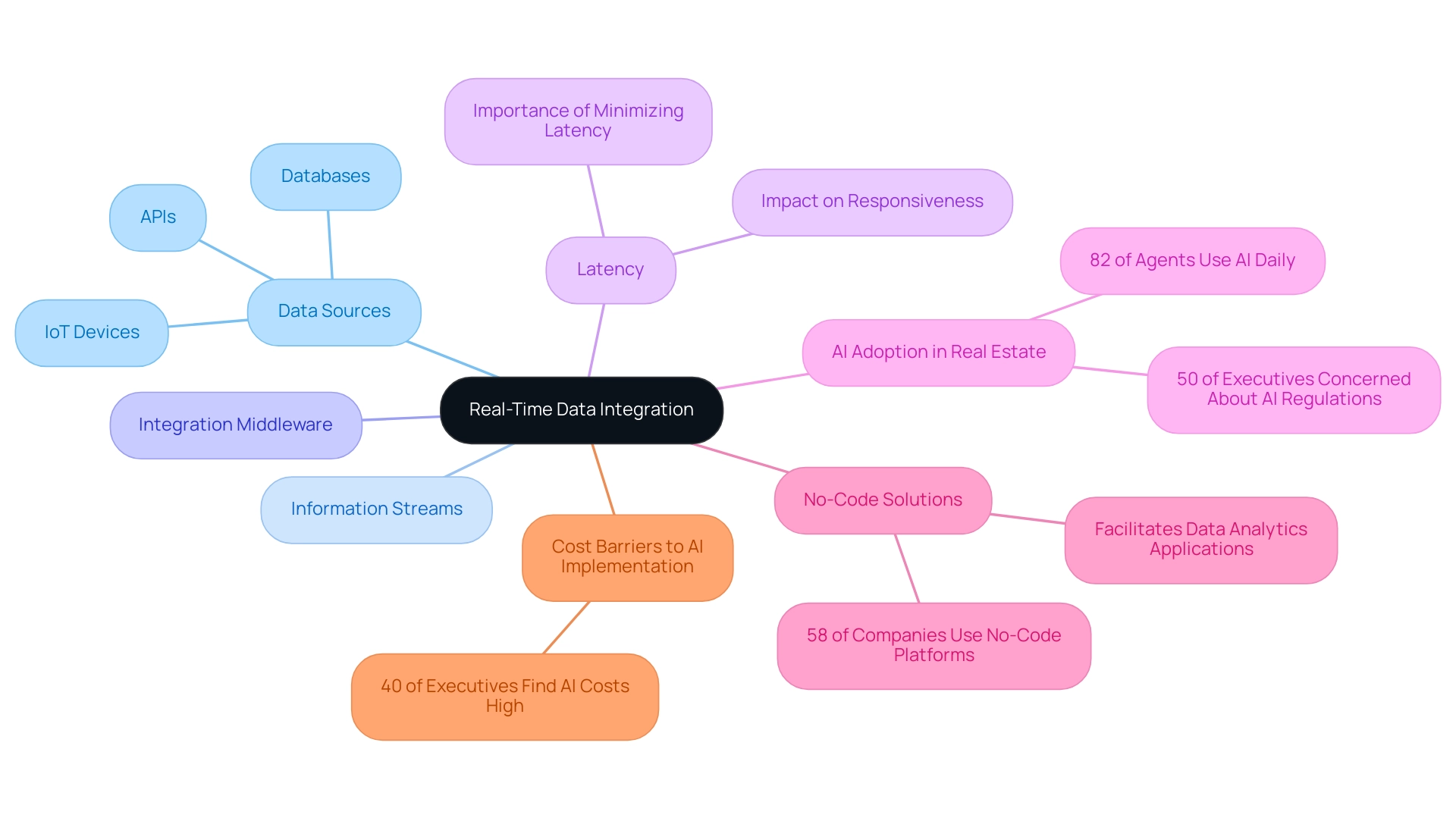
Essential Steps and Best Practices for Implementing Real-Time Data Integration
- Evaluate Your Information Requirements: Start by recognizing the particular kinds of information that need to be combined and the systems from which they will be obtained. It’s essential to evaluate the frequency and amount of updates, as these elements will impact the incorporation strategy. Organizations that articulate their information requirements clearly are better positioned to create effective connection strategies tailored to their business objectives.
- Choose the Right Tools: Selecting the suitable middleware is essential for successful information merging. Evaluate tools based on scalability, compatibility with existing systems, and user-friendliness. In 2024, several advanced tools are emerging that enhance real-time data integration capabilities, making it imperative to stay updated on the latest offerings available in the market.
- Establish Information Governance: Implementing robust information governance policies is essential to maintain quality, management, and security. Clear standards ensure that integrated information remains accurate and reliable. According to Mark Cowan, Chief Data Officer at Put It Forward, connecting systems is no longer sufficient; it's about establishing a cohesive environment where information flows effortlessly and safely. This highlights the significance of governance in enabling effective information integration.
- Develop Integration Workflows: Design comprehensive workflows that define the processes for capturing, processing, and disseminating information using real-time data integration. Efficient workflows assist in simplifying information management and guarantee that all stakeholders have access to the details they require when necessary.
- Test and Validate: Prior to going live, conduct thorough testing of the system to ensure it performs as intended. This involves addressing any issues that arise during testing phases to prevent disruptions in data flow once implemented.
- Monitor and Optimize: After implementation, it’s crucial to continuously observe the system for performance and efficiency. Regular evaluations and modifications will improve the effectiveness of the merging process, aligning it with evolving business goals and user needs. Establishing clear KPIs and SLAs can aid in performance monitoring and ensure that the system meets the defined standards.
Furthermore, as emphasized in the article 'Aggregation in SQL: Functions and Practical Examples,' companies can utilize SQL functions to improve their information unification strategies. Additionally, the case study titled "Establishing Information Unification Approaches" demonstrates how organizations can establish clear information unification strategies and standards that align with their business objectives. This entails recording information sources, setting quality standards, and establishing governance policies, ultimately creating a source-of-truth foundation that ensures consistent patterns and methodologies in information assimilation efforts.
Finally, to guarantee successful information consolidation, it is essential to establish clear business objectives, assess potential ROI, and define KPIs and SLAs for performance evaluation.
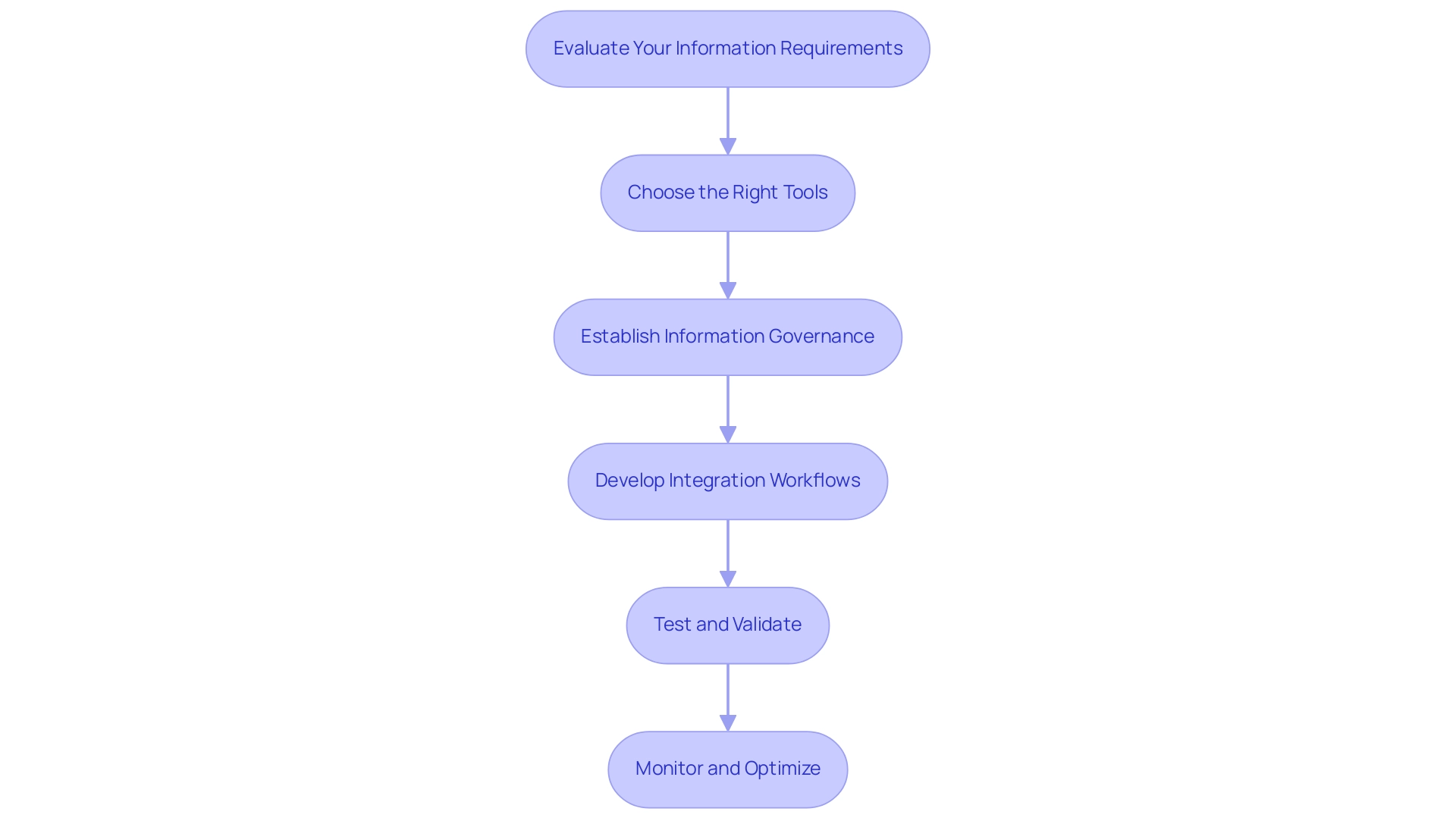
Overcoming Challenges in Real-Time Data Integration
Organizations face various typical obstacles in real-time information unification that can greatly influence decision-making and overall performance:
- Information Silos: The presence of distinct information sources often obstructs seamless unification. To effectively tackle this issue, it is essential to identify all pertinent information sources and incorporate them into a comprehensive unification plan utilizing real-time data integration. By doing so, organizations can ensure a holistic view of their information landscape. The case study of Intrinio illustrates this, as they highlight the significance of choosing a trustworthy information provider to address these silos and improve connectivity capabilities.
- Information Quality Issues: Erroneous or inconsistent information can significantly hinder decision-making processes. To mitigate this risk, implementing robust information cleansing processes is essential. This will assist in sustaining high-quality information, which is essential for informed decision-making and strategic planning.
- Latency Concerns: Achieving real-time unification necessitates minimal latency during information processing. Organizations can optimize their information processing workflows and enhance network performance to reduce delays, ensuring timely access to critical information.
- Stakeholder Resistance: Organizational change often meets resistance from various stakeholders. To promote acceptance, it is essential to involve these stakeholders early in the incorporation process. Addressing their concerns and demonstrating the advantages of real-time information merging can help secure the necessary buy-in.
By proactively anticipating these challenges, organizations can develop effective strategies that facilitate a smoother merging process using real-time data integration. As emphasized by Forrester, customer-oriented firms that effectively manage these challenges can boost their revenue 1.4 times quicker than their non-customer-oriented counterparts, highlighting the strategic benefit of efficient information unification. Moreover, the 2025 Audience Catalog is now accessible for examination, offering further insights into the changing environment of information merging and its effects on business performance.
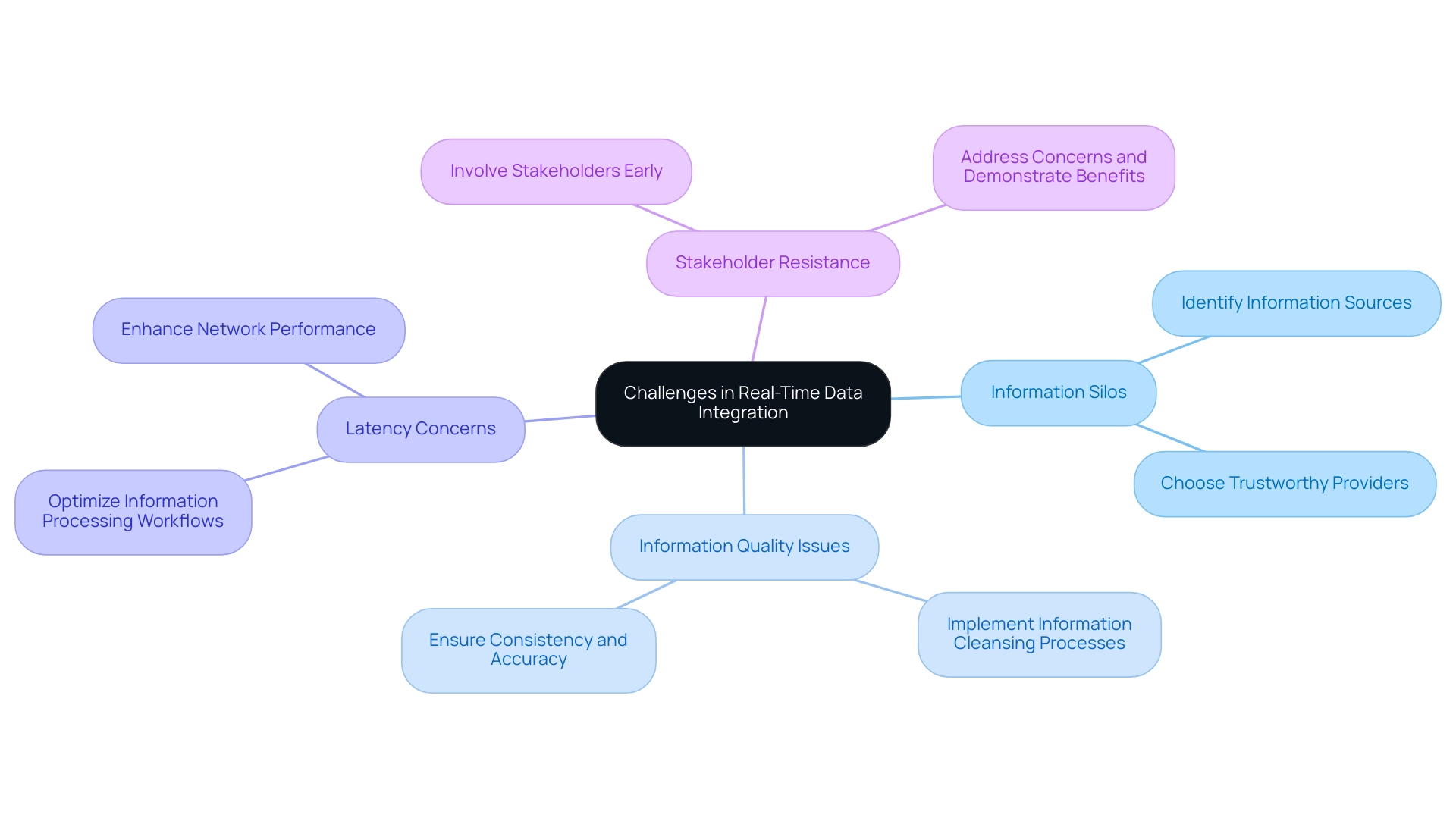
The Benefits of Real-Time Data Integration for Businesses
- Enhanced Decision-Making: The incorporation of instantaneous information enables enterprises to make quick, knowledgeable choices that react skillfully to changing circumstances. This urgency is especially vital in areas such as the sports sector, where the dependence on current information not only satisfies the needs for interaction but also opens new paths for revenue prospects. In fact, a significant 59% of organizations report that integrations lead to improved close rates, as noted by Jon Gitlin, Senior Content Marketing Manager @ Merge, highlighting the importance of timely information in enhancing decision-making processes.
- Improved Operational Efficiency: By optimizing procedures, immediate information access reduces delays and increases productivity. For instance, in manufacturing, live analytics facilitate predictive maintenance and quality control, which are essential in mitigating downtime and ensuring consistent production standards. These capabilities underscore the operational efficiency that supports immediate needs while laying the groundwork for long-term success.
- Enhanced Agility: Organizations utilizing real-time information can swiftly adjust to market fluctuations and evolving customer demands, thus gaining a competitive edge. This agility is essential in today's fast-paced environment, where being responsive can significantly impact market positioning.
- Improved customer experiences are achieved through real-time data integration, which enables personalized interactions and prompt responses that are vital for enhancing customer satisfaction and fostering loyalty. Companies that utilize this information are better prepared to anticipate customer needs and preferences, enhancing overall engagement.
- Cost Savings: The enhancement of operations through real-time information reduces inefficiencies, leading to lower operational costs and increased profitability. As businesses continue to embrace data-driven decision-making, the financial benefits become increasingly apparent, supporting sustainable growth in 2024 and beyond.
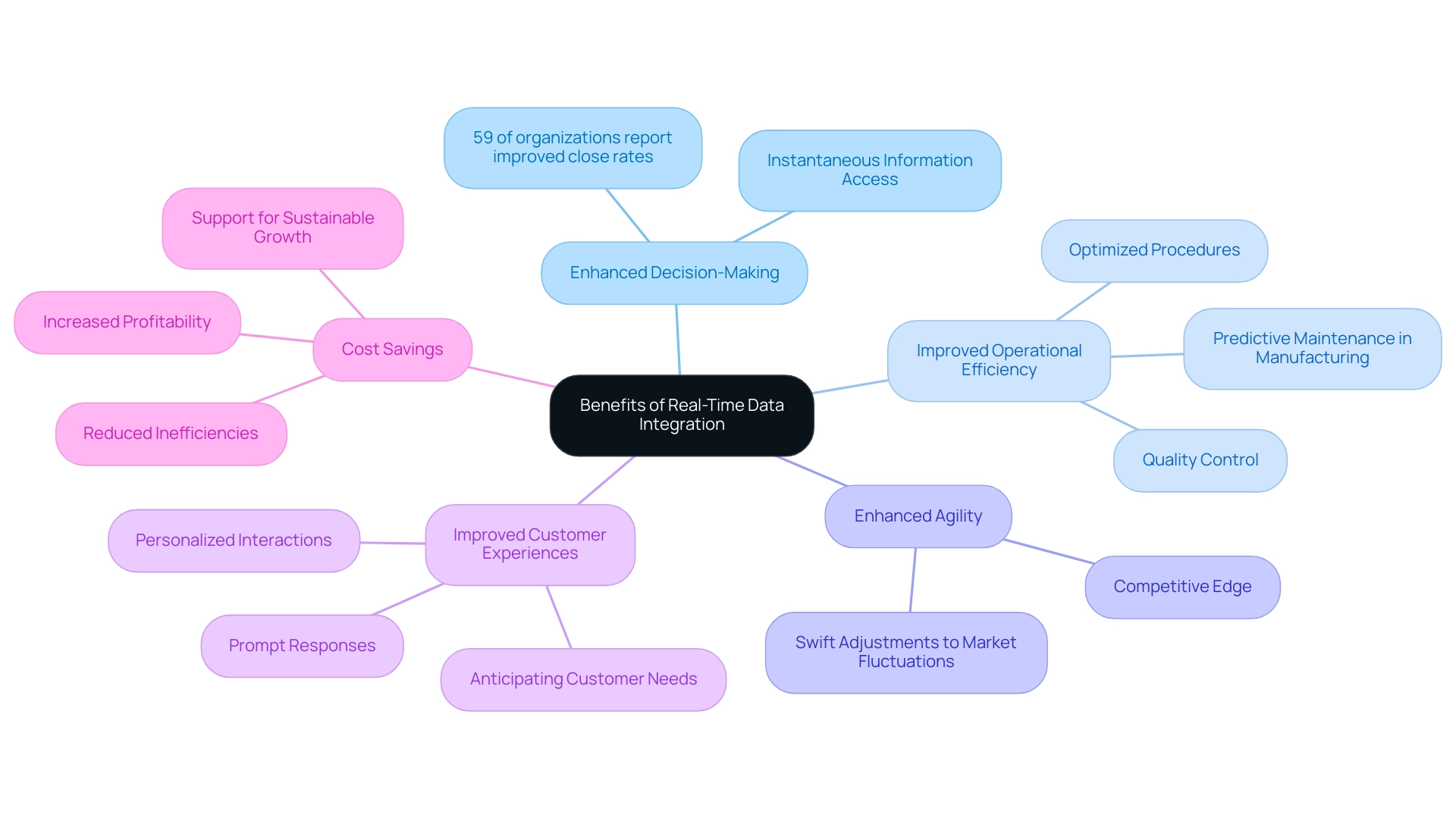
Future Trends in Real-Time Data Integration: What to Expect
- Enhanced Application of AI and Machine Learning: The incorporation of artificial intelligence (AI) and machine learning is poised to revolutionize information merging processes considerably. These technologies are expected to automate routine tasks, thereby enhancing accuracy and operational efficiency. As Rapidi aptly states, Rapidi’s solutions offer real-time data integration for up-to-the-minute information synchronization, ensuring accurate and timely insights across systems. This illustrates the wider trend where AI will not only simplify incorporation but also enhance the dependability of insights.
- Cloud-Based Connectivity Solutions: The transition of enterprises to cloud settings is propelling the use of cloud-based connectivity tools. These solutions offer scalability and flexibility, enabling businesses to adapt swiftly to changing demands. Information unification tools now support collection from sources like Snowflake, Redshift, Hudi, Iceberg, ClickHouse, Doris, and StarRocks, making unification tools that leverage cloud capabilities essential for modern enterprises.
- Increased Focus on Information Security: In response to escalating cyber threats, organizations are placing a heightened emphasis on secure information amalgamation practices. Safeguarding sensitive information has become crucial, prompting companies to incorporate strong security measures into their systems. This trend underscores the necessity for ethical considerations, including privacy and bias, which are critical for responsible practices.
- Connection with IoT Devices: The swift increase of Internet of Things (IoT) devices requires immediate information unification solutions capable of handling extensive streams from various sources. IoT information unification tools employ edge computing to process and analyze information nearer to IoT devices, reducing latency and facilitating real-time decision-making. These tools also incorporate advanced normalization techniques to manage heterogeneous IoT information. By standardizing IoT information unification, companies can optimize processes and improve product development, ultimately driving innovation and competitive advantage.
- Concentrate on Information Management and Adherence: As regulatory landscapes change, organizations must prioritize information governance and adherence within their assimilation practices. Ensuring adherence to legal requirements is essential for maintaining trust and transparency in information handling. This focus will likely drive the development of more sophisticated governance frameworks, further emphasizing the importance of ethical data practices, including data privacy and bias, particularly in the realm of real-time data integration.
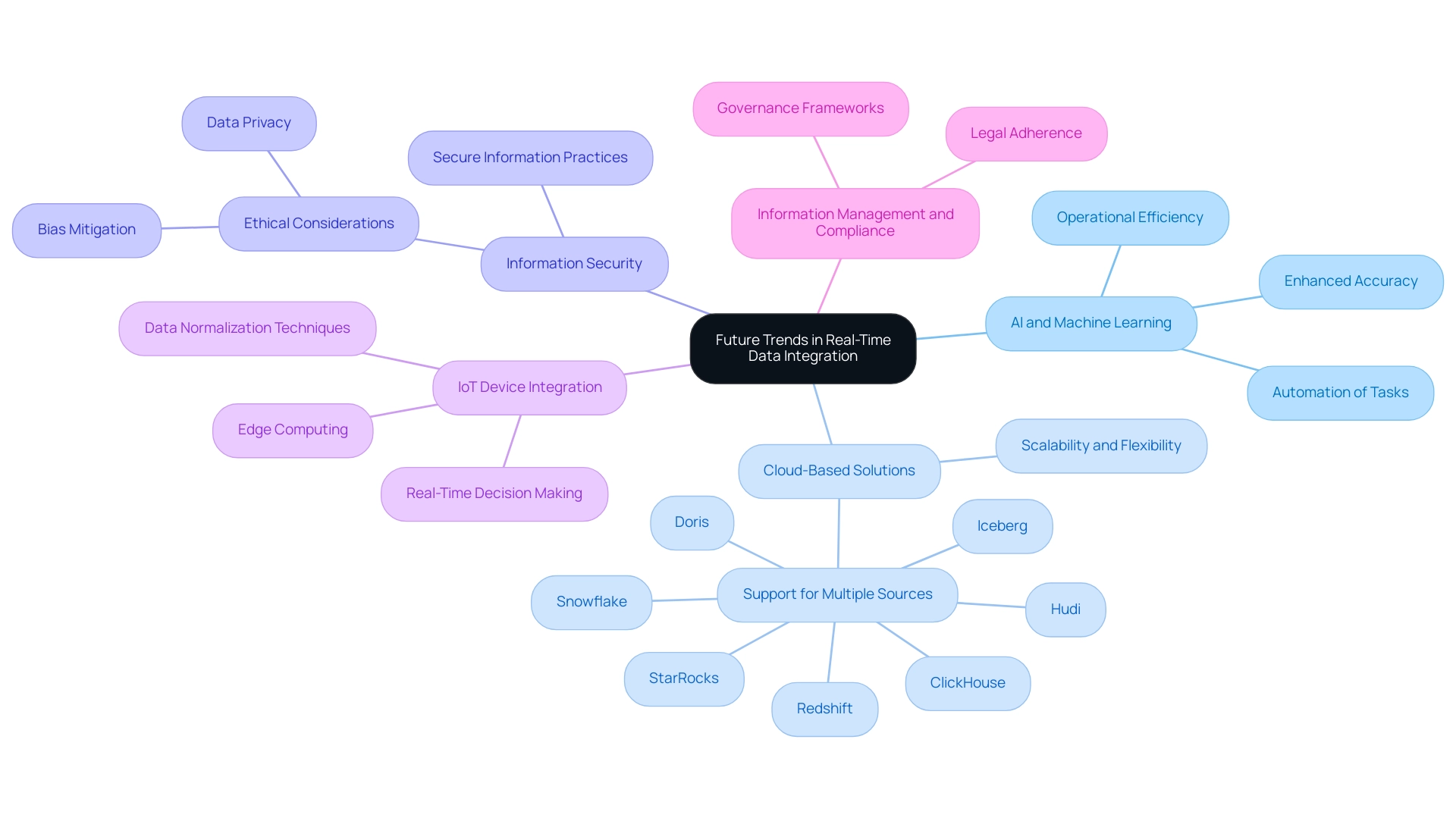
Conclusion
Real-time data integration is a critical driver of operational efficiency and informed decision-making in today’s fast-paced business environment. By continuously updating and synchronizing data across various systems, organizations can harness timely insights to adapt swiftly to market changes. Key concepts such as data sources, integration middleware, and latency play essential roles in shaping effective integration strategies. In particular, the growing reliance on AI and no-code platforms emphasizes the need for organizations to understand and implement these strategies effectively.
Implementing real-time data integration involves a series of essential steps, including:
- Assessing data needs
- Selecting appropriate tools
- Establishing robust governance frameworks
By addressing common challenges such as data silos and quality issues, organizations can overcome barriers to seamless integration. This proactive approach not only enhances data accuracy but also fosters stakeholder buy-in, ensuring a smooth transition to integrated systems.
The benefits of real-time data integration are profound, ranging from improved decision-making and operational efficiency to enhanced customer experiences and cost savings. As businesses increasingly recognize these advantages, the adoption of real-time integration practices is expected to rise significantly in the coming years. Future trends, including the integration of AI, cloud-based solutions, and a focus on data security, will further shape the landscape of real-time data integration, ensuring that organizations remain competitive and responsive to evolving demands.
In conclusion, embracing real-time data integration is no longer a choice but a necessity for organizations aiming to thrive in a data-driven world. By investing in effective strategies and tools, businesses can unlock the full potential of their data, leading to enhanced performance and sustained growth in an ever-changing marketplace.
Frequently Asked Questions
What is real-time data integration?
Real-time data integration refers to the ongoing updating and synchronization of information across various systems as events occur, which enhances decision-making capabilities and operational efficiency for organizations.
What are data sources in the context of real-time data integration?
Data sources are the systems from which data is gathered, including databases, APIs, and IoT devices, each providing unique information critical for analysis.
What are information streams?
Information streams represent the ongoing flow of information that must be processed in real-time to ensure that insights are available immediately after generation.
What role does integration middleware play in real-time data integration?
Integration middleware serves as a bridge that enables the connection and information exchange between distinct systems, simplifying the process of unifying data.
What is latency, and why is it important in real-time data integration?
Latency refers to the delay between information generation and its availability for analysis. Minimizing latency is crucial because organizations focusing on low latency can significantly enhance their responsiveness to market changes.
How prevalent is the use of AI among real estate agents, according to the article?
The article states that 82% of real estate agents currently utilize AI in their daily operations.
What concerns do real estate brokerage leaders have regarding AI?
50% of real estate brokerage leaders express concerns over the lack of adequate AI regulations, which affects the practices of immediate information incorporation, highlighting the need for strong governance to ensure compliance and information integrity.
What barriers do executives face regarding AI implementation?
The case study 'Cost Barriers to AI Implementation' indicates that 40% of executives believe the costs associated with advanced AI technologies and the expertise required for implementation are excessively high, hindering widespread adoption.
How are companies utilizing no-code platforms for analytics applications?
A significant 58% of companies are creating analytics applications using no-code platforms, which facilitate broader access to insights driven by information without requiring extensive programming expertise.
What steps can organizations take to enhance their real-time data integration efforts?
Organizations can evaluate their information requirements, choose the right tools, establish information governance, develop integration workflows, test and validate their systems, and monitor and optimize their processes for effective real-time data integration.

